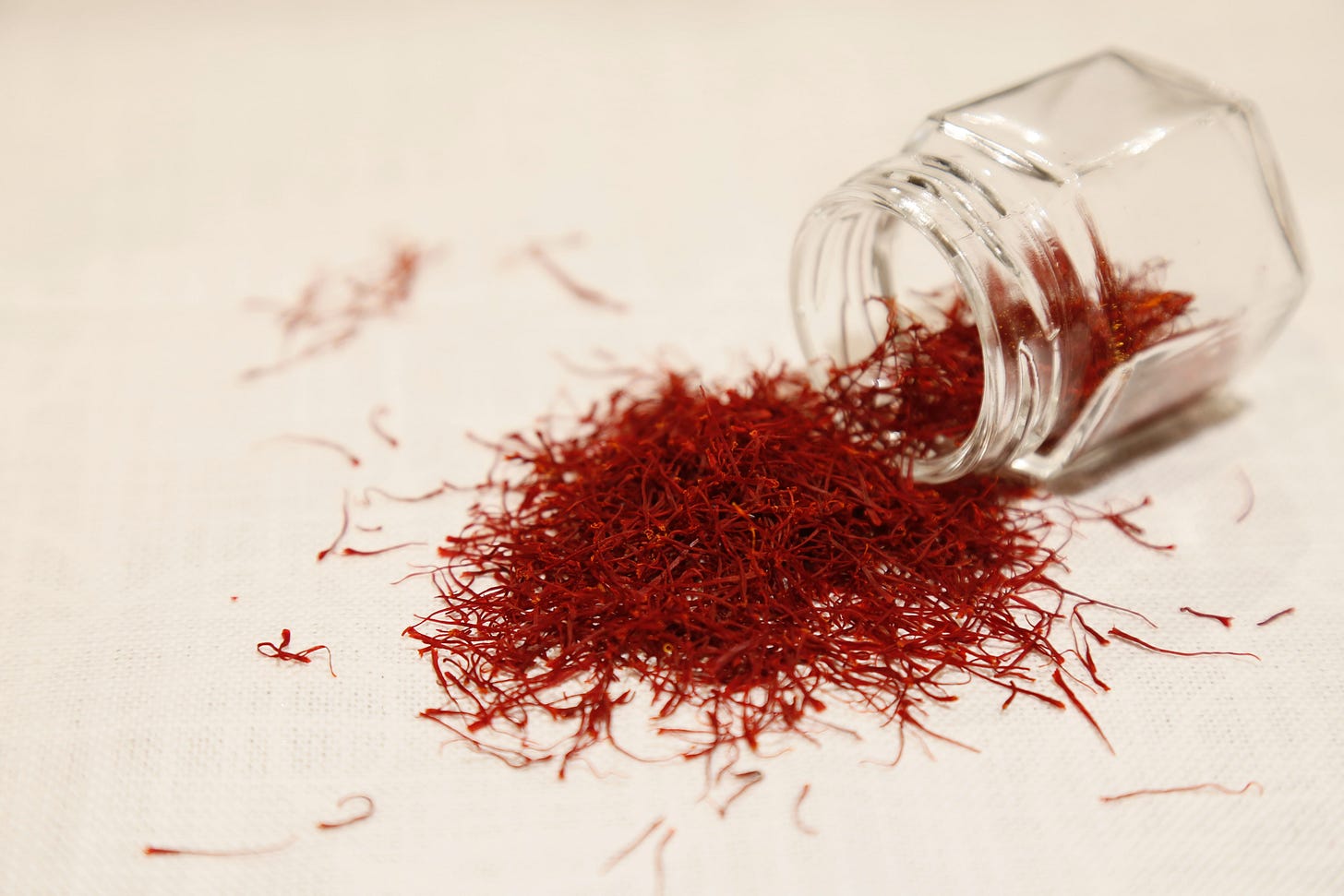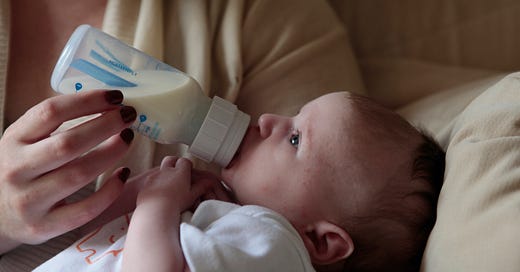Welcome to The Rotten Apple, an inside view of food integrity for professionals, policy-makers and purveyors. Subscribe for weekly insights, latest news and emerging trends in food safety, food authenticity and sustainable supply chains.
Cronobacter in baby formula: what the FDA found (it’s pretty bad!)
New ethical and sustainability law in Germany set to impact global supply chains
Saffron fraud 101
Shrimp-eye tea water (just for fun)
Food fraud incidents and horizon scanning updates from the past week
To hear me read this issue out loud, click here.
Hi,
Last week the US FDA shared what they had seen at the facility accused of causing fatal food poisoning from infant formula. It’s not pretty.
Also this week, I briefly consider how new supply chain due diligence laws in Europe might impact global food supply chains. Plus an update on global saffron fraud from the experts at the Botanical Adulterants Prevention Program.
My favourite new food science discovery of the week was the fish-eye water temperature method. It’s so cool, I can’t believe I haven’t heard about it before.
As always, this issue ends with a list of food fraud incidents and horizon scanning updates that we’ve added to our database in the past week.
Please keep sharing this newsletter, it really helps to make my efforts worthwhile. And feel free to reply with feedback, I read every response.
Cheers!
Karen
P.S. Click the button below to share, I don’t use subscribers’ email addresses for anything else, and you don’t get added to any other list. Ever.
Food Safety
The Baby Formula Cronobacter Recall: What the FDA Found
Last month I wrote about the now-infamous Cronobacter baby formula recall and hypothesised that there were hygiene issues at the production facility.
Those suspicions were confirmed. Last week the US FDA shared what they saw when they inspected the production facility in February and March. It was their third inspection of that facility in two-and-a-half years.
The recall has now been linked to a second officially acknowledged death, with possibly more to come. The US Centers for Disease Control and Prevention (CDC) is currently investigating other cases to find out if they, too are linked to the same batches of infant formula. That’s not as easy as you might imagine: healthcare providers are not obliged to report Cronobacter illnesses to the authorities in the USA.
Last week’s report doesn’t include any final conclusions about actual regulatory violations, it just shares observations. And they are not pretty.
Pathogens in the facility
The FDA inspectors found Cronobacter sakazakii on a hopper that was being used to drop small plastic scoops into containers of formula. Once inside the containers, the scoops are directly in contact with the formula.
They also found C. sakazakii on the floor near a dryer and a door in a production area.
They also found it in a spot where debris had collected between duct tape on the floor and an adjacent wall. Duct tape on the floor is a big food safety no-no. Tape and other “temporary engineering solutions” can collect food debris. The food debris allows pathogens to evade cleaning regimes and proliferate in the food, meaning more pathogens in a facility.
It wasn’t just the FDA finding Cronobacter around the factory. The manufacturer had already found it on eight occasions in 2020 and 2021 and they found it twenty times in February 2022, including in ‘high care’ areas. High care areas are areas that are critical to hygiene, often places where there is open, exposed product.
Pathogens in the product
It’s one thing to find the pathogen in a factory, but was it getting into the product? Yes. The company’s own product testing records showed that two batches from 2019 and 2020 contained Cronobacter.
GMP failures
GMP stands for good manufacturing practices.
In addition to duct tape on the floor, there were numerous leaks, condensation and standing water in the factory. The FDA proposed that one of the dryers was not being properly dried after cleaning. The report also said there were cracks and pits in the main chamber of at least two of the facility’s milk/liquid dryers.
While formula was being produced, the FDA inspectors saw workers fail to sanitise their shoes correctly before they entered production areas. Some did not sanitise their shoes at all.
The company blamed the facility contamination on building contractors who were walking on the roof and who didn’t change or sanitise their shoes before coming inside again. However, the company’s own procedures should have prevented this from happening in the first place.
Failures in consumer complaint handling
The company did not follow their own procedures for investigating consumer complaints, which include the need to test retained samples for microbial pathogens. The FDA said they treated infant death and infant illness “the same”, I assume with respect to the degree of the seriousness of the complaint. The report says the company “Closed” a complaint investigation without performing testing on product from the batch in question.
Overall
The FDA summarised their observations as follows:
- There was no system of process controls to control biological hazards
- Food contact surfaces were not “maintained to protect infant formula from being contaminated”.
Wow.
Learnings
Next week I’ll explain the challenges that manufacturers face when attempting to keep pathogens like C. sakazakii out of infant formula. And unpack why the FDA inspectors were so concerned about the leaks, condensation and other water in the facility.
In short: 🍏 One more death and possibly more illnesses have been linked to the recalled formula 🍏 An intensive investigation at the production site found hygiene problems and poor practices 🍏 Cronobacter sakazakii was found at multiple sites in the facility, months after the first death was reported and more than 3 months after the FDA first raised concerns 🍏 The manufacturer did not test retention samples of the affected batch after receiving a compliant about an infant death for that batch 🍏
https://www.cdc.gov/cronobacter/outbreaks/infant-formula.html
The FDA report: https://www.fda.gov/media/157073/download
Supply Chains
New Ethical And Sustainability Laws To Impact Global Food Supply Chains
Ethical and sustainable practices in global supply chains will be impacted by a new law in Germany. The law requires German companies of a certain size to investigate their supply chains and take adequate measures to prevent or mitigate human rights risks and environmental risks.
The law comes into effect for companies with more than 3000 employees in 2023 and for companies with more than 1000 employees in 2024.
Unlike a similar French law, the German law covers indirect suppliers with whom the German company does not have a direct commercial relationship. This new law could motivate suppliers to become less transparent and more clandestine about unethical practices so as to protect their business with German companies. Child labour, which is important to some food-producing communities in developing countries, is one area where local and international rules and perceptions may disagree.
Other countries in the European Union are expected to follow with similar rules in the next few years. Legislation at the European Union level has been proposed. The proposed directive will make supply chain due diligence mandatory for all large and listed companies in the EU.
This isn’t just a European thing. I have heard it said (anecdotal evidence only) that US customs is stopping shipments at their borders, requesting evidence from importers that their products are free from child labour, under the US Forced Labour Prevention Act.
This issue is not new. For example, in 2016, a survey of farmed prawns, salmon and sea bass labelled as "responsibly farmed” or “responsibly sourced” in UK supermarkets found discrepancies. The majority of the products were rated by the Marine Stewardship Council as ‘level 3’, meaning that from an environmental perspective they were not responsibly sourced.
It’s hard to agree on the finer details of what makes an ethical or sustainable supply chain, and this is where food businesses are going to struggle. What may be considered to be ethical sourcing in 2022 might be considered unsatisfactory in five or ten years’ time.
The first step should be to gain full oversight of every supply chain, so you at least know what is happening. That’s the theory anyway. Once you have an idea of what is happening in a supply chain you can start to make judgements about what is acceptable and what is not. In practice, however, we have a long way to go with transparency in food supply chains. This new German law is yet another incentive to get more serious about collecting detailed information from suppliers and their suppliers. Every step is a step in the right direction.
In short: 🍏 A new German due-diligence law will affect global supply chains 🍏More will follow in Europe and elsewhere 🍏 Motivation to make fraudulent claims about labour practices and environmental management may increase as a result of the new laws 🍏
Sources:
https://www.theguardian.com/environment/2016/sep/25/the-eco-guide-to-buying-fish
Food Fraud
Saffron Fraud
The Botanical Adulterants Prevention Program has published a new bulletin on saffron and saffron extracts. Their aim is to provide timely information on issues of adulteration, including the occurrence of adulteration, the potential consequences and the overall saffron market situation.
Here’s what you need to know. A link to the full report is provided (as always) below.
Saffron the spice is the dried stigma, part of the flower, of saffron the plant (Crocus sativus). You can see the red stigmas in the pictures.

Genuine saffron is harvested by hand, highly prized for its colour and flavour and very expensive. In fact, it is the most expensive spice and costs between USD $1,100 to $11,000 per kg. The international saffron market was worth US $430 million in 2018.
Saffron trade is complicated. Saffron’s most important growing areas are in Iran, Greece, Morocco and India. Afghanistan and Spain are also important sources of saffron. Saffron labelled Spanish is mostly grown in other countries but packed in Spain. Iran accounts for most global production at 90% – 93% but only accounts for 40% of direct global exports, according to the report (confusing!), apparently because the Iranian saffron is resold by other countries.
With so much of its production in one country, and with a short harvesting season, saffron supply is extremely vulnerable to weather events. For example, there was a tripling of prices from 2006 to 2009 because of heavy frost in Iran in 2007. Climate change is a threat, with increased moisture in some areas leading to more fungal plant diseases, and drought in other areas limiting yields.

Saffron fraud
Saffron is one of the most frequently adulterated foods.
Powdered saffron is more at risk than whole saffron.
The biggest food safety issue with saffron fraud is probably the use of synthetic dyes to boost the colour of fraudulent whole saffron and saffron powder. Sudan I-IV and Rhodamine B dyes have been found in saffron and are considered potentially genotoxic and carcinogenic.
Adulterants in whole saffron
Here are some of the things that are added to saffron to fraudulently increase its value.
Parts of saffron flowers, including the yellow style and the white style.
Filaments from other plants, including corn fibres, safflower stigmas, calendula stigmas, pomegranate fruit fibres
Filaments from other sources including silk. Adulterant filaments may be dyed with plant dyes including beetroot, pomegranate, fruit peel.
Liquids that are added to increase weight, including oils, glycerin and honey
Dyes and aroma compounds as listed below
Adulterants in saffron powder
Here are some of the things that are added to saffron powder to fraudulently increase its value.
Turmeric powder
Paprika powder
Ground seeds of sweet fennel, or annatto
Dried marigold flowers
Gardenia (Cape Jasmine) extract, for their crocetin esters which are also in saffron
Natural dyes from flowers and roots
Artificial dyes including erythrosine, ponceau 4R, tartrazine, Sudan dyes, magenta III and rhodamine B
Safranal, which is a synthetic aroma compound
Also, there are historical reports of fillers added for increasing the product’s weight, including chalk, gypsum and heavy spar (barium sulfate)
Other types of fraud (non-adulteration-type fraud)
Selling Philippine saffron or “saffron flowers” as if they are real saffron (C. sativus). They are instead safflower or kasubha.
Exhausted saffron sold as whole saffron
Coloured paper shreds sold as saffron
Provenance fraud, in which the geographical origin of the saffron is misrepresented
Saffron testing
Testing is a challenge. Microscopic inspections can be done on powdered as well as whole saffron, but they are time-consuming and expensive. In addition, visual examinations won’t necessarily recognise adulteration with colourants or safranal.
Some DNA-based tests struggle to differentiate safflower from saffron, because they are closely related. DNA tests also don’t find safranal or dyes. Spectroscopic methods can be simple and quick but they are not very sensitive and won’t pick up all adulterants. There are many other authenticity test methods, each with its own challenges. It is recommended that a suite of complementary tests be used to cover all types of adulteration and fraud. Provenance testing has been successfully done using stable isotope methods.
Just for Fun
Shrimp-Eye Tea Water
Oh I just love this!
Often in cooking, we need water to be at 100 degrees, which is fully boiling. (That’s 212 F for non-metric readers!) Except when we are steeping tea. Delicate green teas taste best when steeped at temperatures lower than boiling. So if you don’t want to use a thermometer every time you make tea, what should you do?
The Chinese are on to it.
Introducing the fisheye water temperature method. It has been used for almost a thousand years. Yep, one thousand. It was recorded in a Chinese book published in 1049. And it’s a doozy.
In this method, the bubbles in a pot of heating water are described by comparing their size to the eyes of sea creatures. So shrimp-eye sized bubbles are the little bubbles that form first on the bottom of a pot. Crab eyes form next, then fish eyes, which start to rise from the bottom of the pot. Next up is string of pearls, a steady stream of bubbles, then raging torrent.
🍏 Shrimp eyes occur at about 70 degrees (155 F). Use this temperature for steeping delicate and very fine-leafed green teas.
🍏 Crab eyes occur at 80 degrees (175 F). For delicate oolongs and white teas.
🍏 Fish eyes occur at 85 degrees (185 F). Use this temperature for oolong teas and some delicate black teas.
🍏 String of pearls temperatures are 90 – 95 degrees (200 F). This is perfect for aged teas and whole leaf black teas.
🍏 Raging torrent is fully boiling water, 100 degrees (212 F). Use it for strong black teas and herbal teas.
Thanks to @Botanygeek (James Wong), a science writer on Twitter for opening my eyes to the fish eye temperature method!
Food Fraud Incidents and Horizon Scanning
Food fraud incidents added to Food Fraud Risk Information Database in the past week
Pet food has been found to contain shark meat from species considered endangered or threatened species. Note: It is unclear whether the sharks were harvested illegally, which would make their use in pet food potential food fraud. No claims about sustainability or species were on the packages – Singapore.
https://www.frontiersin.org/articles/10.3389/fmars.2022.836941/full
Pickled turnips from Lebanon have been found to contain the unauthorised colourant rhodamine B by Germany.
https://webgate.ec.europa.eu/rasff-window/screen/notification/538025
Sumac spice adulterated with the unauthorised and carcinogenic colourant Sudan IV has been reported by Germany 10/03/2022
https://webgate.ec.europa.eu/rasff-window/screen/notification/536362
Food fraud horizon scanning (other updates to the Food Fraud Risk Information Database in the past week)
Eggs
Any British eggs marked "free-range" as of 21st March 2022 are fraudulent. This is because hens have not been allowed outside due to bird flu controls, therefore the eggs do not meet definitions of free-range. This is expected to continue for at least one more month - United Kingdom 19/03/2022
Additives
The European Union has decided to ban the additive E171, titanium dioxide, from foods. The ban will take effect in mid-2022 and have a six month transition period. The United Kingdom is not banning titanium dioxide and it is still permitted in most countries outside of Europe. Some foods containing titanium dioxide will be very difficult to reformulate. There is a risk that European food importers will knowingly or unknowingly import foods or ingredients that contain undeclared titanium dioxide, in contravention of the rules - Europe 19/01/2022
https://www.food-safety.com/articles/7513-europe-to-ban-titanium-dioxide-in-food-from-mid-2022
Sustainability and Ethical Claims
Ethical and sustainable practices in global supply chains will be impacted by a new supply chain due diligence law in Germany. The law requires German companies of a certain size to investigate their supply chains and take adequate measures to prevent or mitigate human rights risks and environmental risks. This new law could motivate suppliers to become less transparent and more clandestine about unethical practices in order to protect their business with German companies. Child labour, which is important to some food-producing communities in developing countries, is one area where local and international rules may disagree – Global 08/08/2021 https://www.jonesday.com/en/insights/2021/08/the-impact-of-french-and-german-esg-due-diligence-laws-on-business
Sunflower oil
Sunflower oil is at heightened risk of food fraud due to supply constraints and very high prices. These have been caused by the Ukraine war. Ukraine is the world’s largest exporter of sunflower oil. India is one market that will be affected, being a net importer of edible oils, with sunflower making about 10% of all oils consumed in India.
Cover image (baby) credit: Photo by Lucy Wolski on Unsplash




I love the fish eye tea water story! In "In Making Numbers Count: The Art and Science of Communicating Numbers" by Chip Heath and Karla Starr, they explain the importance of using visual aids to better communicate numbers and size. I love thinking of fish eye size instead of millimeters (or fractions of them!)